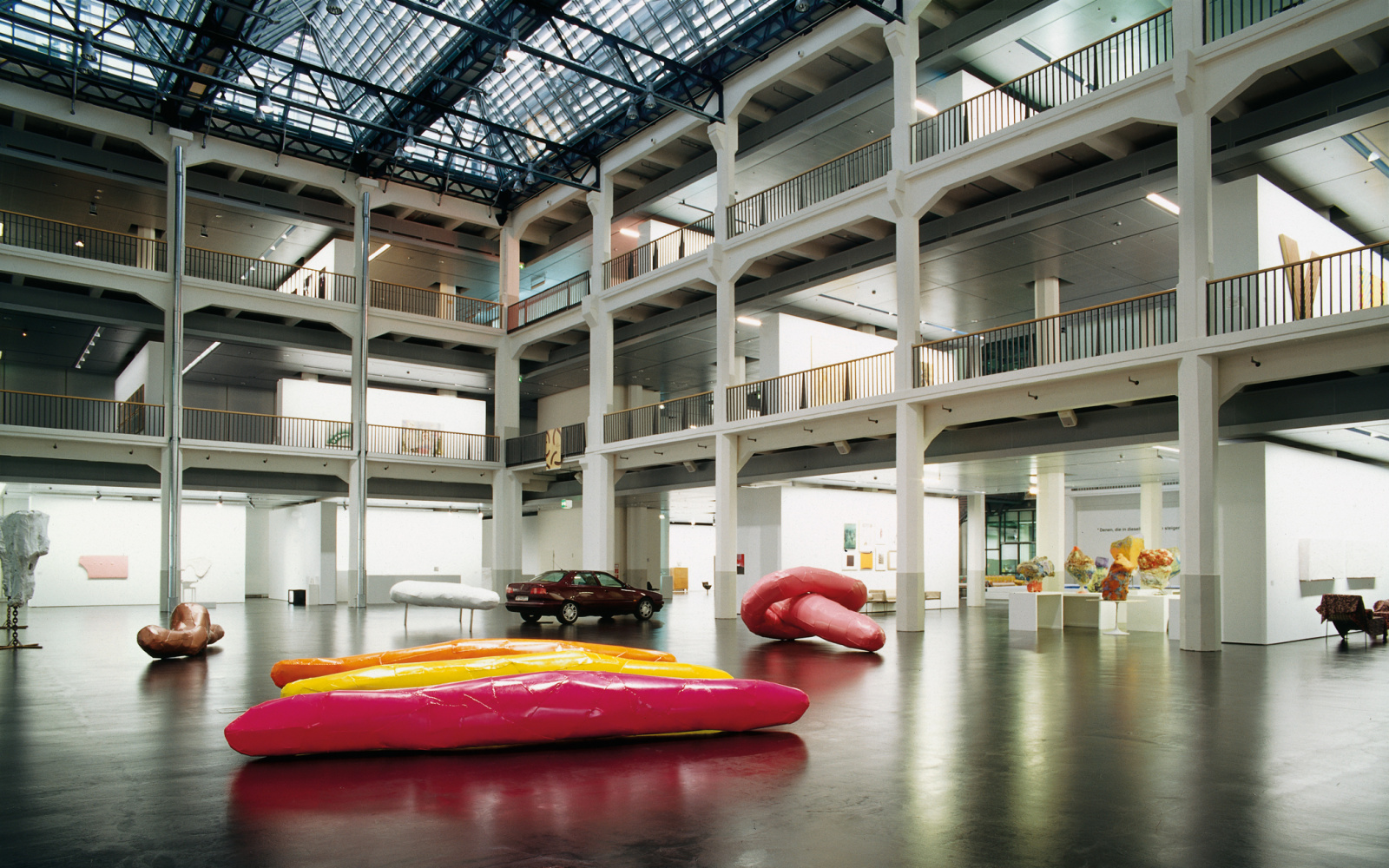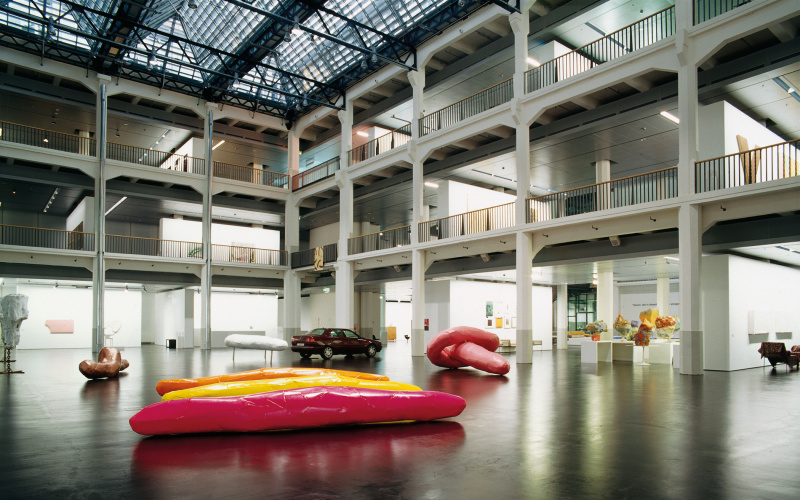- Event
- Opening
Franz West: In & Out (opening)
Sat, December 02, 2000 6:00 pm CET
In collaboration with the Museo Nacional Centro de Arte Reina Sofía in Madrid, the ZKM Museum of Contemporary Art (MNK) is mounting a comprehensive show of work by Franz West. Distributed over the two light courts of the museum, the wide-ranging exhibition offers a survey of the oeuvre of this artist, who was born in Vienna in 1947. It is Germanyís first large-scale show devoted solely to Franz West and spanning his different areas of work.
The artistís creative periods are successively conveyed through installations, sculptures, furniture, video works and prints, including significant pieces from the Grässlin collection housed in the MNK. With a focus clearly placed on recent and new work, some exhibits will be on public view for the first time. Particular interest is likely to be roused by the large-scale aluminium sculptures and installations arranged by Franz West in configurations responding to the architecture of the Museum of Contemporary Art. In the second court of the museum, for instance, canopied rafts moored in a large water basin invite visitors to venture onto unsteady ground.
Despite being deeply impressed by Viennese Actionism in his youth, Franz West embarked upon his artistic career in the mid-1970s with wholly self-reliant sculptures and graphics. In the course of the past ten to fifteen years, he has become one of the most influential sculptors at international level, as indicated by, among other things, his inclusion in major exhibitions (such as the documenta IX, 1992, and X, 1997, the Venice Biennale, 1990, sculpture projects in Münster in 1987 and 1997), and numerous one-man shows in Europe and the USA (including Vienna, Prague, Porto, Malmö, Los Angeles, Chicago). His early ëadaptivesí - a series of sculptures he has continuously advanced up to the present day ñ solicit the active spectator participation that is a leitmotif running through his work. The lifting, holding, and ëapplyingí of these apparently non-functional sculptures is integral to the original concept of the series and encourages the viewer to enter into a physical connection with artworks that without this involvement would remain incomplete.
Similarly, his furniture sculptures and installations ñ the divans, chairs and banks ñ are works of art complemented by the body of the viewer who chooses to sit down on them. The perception of the seated viewer is liable to be confused by adjacent works such as the abstrusely shaped, often intensively coloured, pieces belonging to other groups of sculptures, whose placement on pedestals shows them also to be works of art. Franz Westís ironic and playful titles point to the influence of writings by philosophers and psychologists such as Ludwig Wittgenstein or Sigmund Freud. The artist, however, does not intend such titles to provide assistance in understanding his creations. It is more the case that the cultural environment and the occupation of the same is an important theme of his work, with the direct, physical ñ as opposed to purely intellectual ñ participation of the artist, and viewer too, playing a vital role in the creative process.
In this regard, Franz West shows himself to be an important representative of a mode of interactive art whose immediacy and sensuality directly appeals to the perceptive faculties. One aspect that will become especially clear in this Karlsruhe exhibition is the multifaceted and manifold transition from classical museum presentation - pure ëexhibitsí behind glass and on pedestals - to three-dimensional environments that solicit the usage of museum visitors.
Franz West lives and works in Vienna.
The artistís creative periods are successively conveyed through installations, sculptures, furniture, video works and prints, including significant pieces from the Grässlin collection housed in the MNK. With a focus clearly placed on recent and new work, some exhibits will be on public view for the first time. Particular interest is likely to be roused by the large-scale aluminium sculptures and installations arranged by Franz West in configurations responding to the architecture of the Museum of Contemporary Art. In the second court of the museum, for instance, canopied rafts moored in a large water basin invite visitors to venture onto unsteady ground.
Despite being deeply impressed by Viennese Actionism in his youth, Franz West embarked upon his artistic career in the mid-1970s with wholly self-reliant sculptures and graphics. In the course of the past ten to fifteen years, he has become one of the most influential sculptors at international level, as indicated by, among other things, his inclusion in major exhibitions (such as the documenta IX, 1992, and X, 1997, the Venice Biennale, 1990, sculpture projects in Münster in 1987 and 1997), and numerous one-man shows in Europe and the USA (including Vienna, Prague, Porto, Malmö, Los Angeles, Chicago). His early ëadaptivesí - a series of sculptures he has continuously advanced up to the present day ñ solicit the active spectator participation that is a leitmotif running through his work. The lifting, holding, and ëapplyingí of these apparently non-functional sculptures is integral to the original concept of the series and encourages the viewer to enter into a physical connection with artworks that without this involvement would remain incomplete.
Similarly, his furniture sculptures and installations ñ the divans, chairs and banks ñ are works of art complemented by the body of the viewer who chooses to sit down on them. The perception of the seated viewer is liable to be confused by adjacent works such as the abstrusely shaped, often intensively coloured, pieces belonging to other groups of sculptures, whose placement on pedestals shows them also to be works of art. Franz Westís ironic and playful titles point to the influence of writings by philosophers and psychologists such as Ludwig Wittgenstein or Sigmund Freud. The artist, however, does not intend such titles to provide assistance in understanding his creations. It is more the case that the cultural environment and the occupation of the same is an important theme of his work, with the direct, physical ñ as opposed to purely intellectual ñ participation of the artist, and viewer too, playing a vital role in the creative process.
In this regard, Franz West shows himself to be an important representative of a mode of interactive art whose immediacy and sensuality directly appeals to the perceptive faculties. One aspect that will become especially clear in this Karlsruhe exhibition is the multifaceted and manifold transition from classical museum presentation - pure ëexhibitsí behind glass and on pedestals - to three-dimensional environments that solicit the usage of museum visitors.
Franz West lives and works in Vienna.
Organizing Organization / Institution
ZKM

